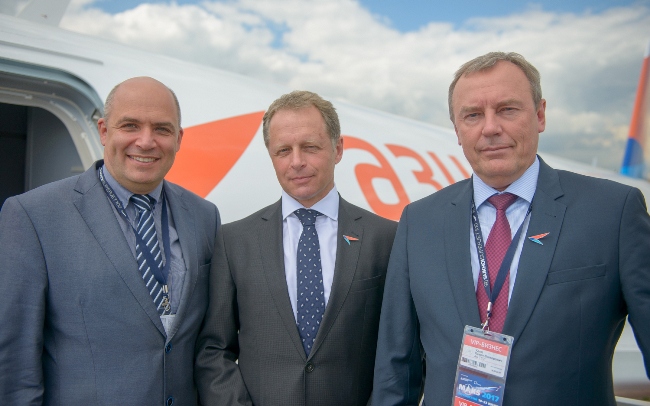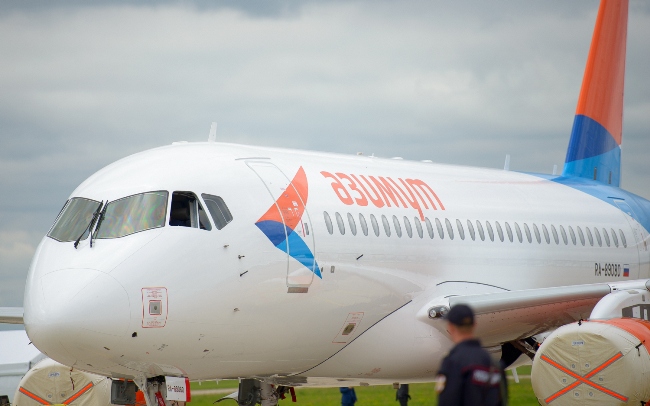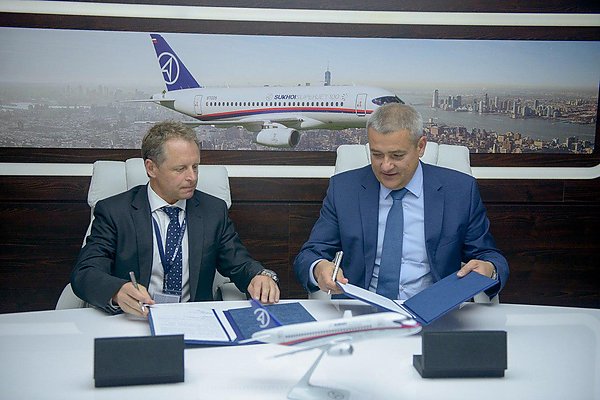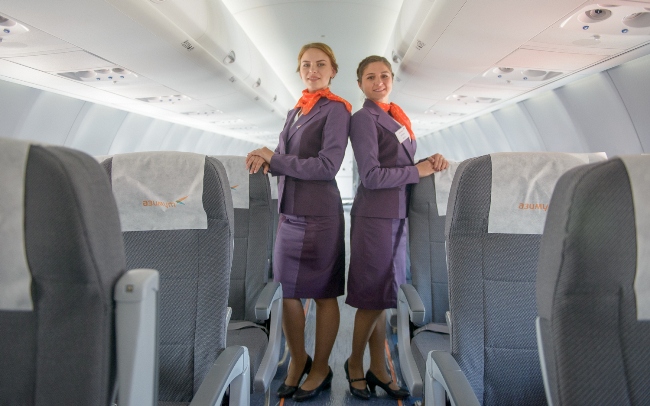- Pavel Viktorovich, there are a lot of discussions around the new Russian airline Azimuth, but it is still not very clear what is the essence of this business decision? Why Rostov? Why Sukhoi SuperJet 100?
- This idea was born almost three years ago, when we saw that in the south of Russia, even during the crisis of air transportation in the country, on the contrary there was an increase in passenger traffic. Yes, for objective reasons. People began to fly less abroad, and in the Southern Federal District the dynamics of passenger traffic growth in recent years proved to be the highest. And in general, in terms of domestic traffic, the Southern Federal District is now in second place after the Central, ahead of both the North-Western and all others. At the same time, there was almost no airlines in the south of Russia. If we talk about today and regular transportation, then they simply do not exist.
At the same time, the ground infrastructure was actively developing in the region. New modern airports were opened: Sochi, Anapa, Gelendzhik, Rostov and Krasnodar are on the way. It is in the south that infrastructure construction is proceeding at a fairly high rate. And the demand for flights, as we say, bypassing the Moscow aviation hub, remains. In 2014 the program 12.12 - the subsidisation of regular shipments began to work. Many routes in southern Russia were included in this program. In the future, it was transformed by priority - first of all it is non-alternative routes, hard-to-reach regions, mainly Siberia and the Far East. But there are also quite a few routes that work on the principle of co-financing. And the administrations of these already southern regions - the Rostov region, the Krasnodar Territory, are ready for this. The most striking example of "Rostov - Makhachkala" is to fly through Moscow uncomfortably, and the route is in demand. It is clear that "rolling it" with the support of the state and subsidising the routes will be much easier. After all, that's why these programs exist to develop regional transportation.

Executive Director Eduard Teplitsky, CEO Pavel Ekzanov, Chairman of the Board of Directors Pavel Udod
We have 3 main segments in the business model: 1) flights within the Southern and North-Caucasian federal districts; 2) flights connecting the major cities of the south (Krasnodar, Rostov, Sochi, Mineralnye Vody) to the cities of the Volga, Ural, Siberia, which are within reach - the maximum range of the Sukhoi SuperJet 100 aircraft, bypassing the Moscow air hub; 3) transit flights through major hub airports (now Rostov, and Krasnodar also has the right to this status) from the CIS to Europe. When I worked in the airline "Yakutia", we had airplanes based in Krasnodar. For example, routes from Kazakhstan to Germany were in demand, but the infrastructure did not allow them to be convenient for the passenger - there was no transit zone at the airport. Now in Rostov a new modern airport with all the necessary options for transit passengers. Krasnodar is also our base airport. The first route network, which was designed for this winter for 4 aircraft, includes 15 routes: 4 from Krasnodar and 11 from Rostov. The next airport, which we look at as a base, is Mineral Waters.
So it turned out that the traditional international routes from the cities of the south are now carried out by foreign companies. And before there was always parity. For various reasons, Russian airlines have left the Southern region: someone went bankrupt, someone in the process of reorganisation, someone in the concept of merging. As a result, there were no residents left. At the same time, passenger traffic itself did not decrease, and the concentration of flights to Moscow on the contrary increases. But in the regions does not grow. In flights that airlines perform on direct routes, bypassing Moscow, there is no system. This we have seen in the past few years: companies are coming, someone is not systematically flying for a month, someone is two, someone is a season, and it works, there is demand. But as soon as people start to get used to it, everything suddenly stops.
That's the idea of the southern airline was born, and now we decided to implement it. Of course there were many assessments, for a long time everyone analysed, it is understandable, and the crisis made its own adjustments. For a long time looked at the aircraft, analysed various types. For example, the Bombardier Q400 - he flew in Yakutia on the program 12.42. Also looked Embraer. But, recently, since last year, when we started active operations under the Sukhoi SuperJet 100 support program, they showed that the economic model of this aircraft was the most interesting. There are, of course, several conditions that have not yet been tested in practice. These are some programs through the Ministry of Industry and Trade of Resolution 745 (on subsidising a pool of spare parts, training personnel, equipment that is supplied) - it was launched, but there was no practical example.

All other programs have already started to work more or less, SuperJet has entered the program 12.12. If you remember, initially it was not there, then he went in there with the new planes, and then all went in. Accordingly, when we saw that all these programs are being implemented, it became obvious that this type of aircraft becomes the most economically attractive. On the other hand, it's the SuperJet that allows you to solve all three tasks identified in our transportation concept. The longest route we have is "Rostov - Novosibirsk", and Sukhoi SuperJet 100LR quietly, without any restrictions, allows you to perform this flight.
- With full commercial download?
- Yes. Without limitation. At it at full passenger loading the maximum distance of 4200 km, and from Rostov to Novosibirsk 3 thousand km. That is, there is still a stock. Even a five-hour flight for LR is a normal route. This is the first. Second, where there is a low passenger flow, many companies carry out flights seasonally, since in winter they can not load their planes, so simply the flights are canceled. The Sukhoi SuperJet 100 is a good opportunity both in summer and in winter to fly, and that a business passenger can fly, and that you can make some kind of alternative to other modes of transport. This is possible on airplanes of just such a small capacity as the SuperJet, with a sufficiently long flight range. Moreover, it can cover all segments, both short and long, do not have to have several types in the fleet, which undoubtedly reduces costs.
- You ordered 12 Sukhoi SuperJet 100 aircraft, and on MAKS-2017, they ordered four more. Are they all LR modifications?
- Yes, all LR. When we started implementing this business model, we did not expect that the bundling of the same spare parts pool, or rather our own warehouse, would be a rather complicated issue. It's one thing - what we want, the other is whether the manufacturer can provide it or not. But we did a good job with the Sukhoi Civil Aircraft Company. Completely this list agreed, having spent for this a certain amount of time, and came to understand. Right now we got the first two planes, and we have already formed a spare parts warehouse for 230 million rubles. The third and fourth sides will be taken in the next two weeks after the MAKS airshow.
- What is the delivery schedule for all the aircraft you ordered?
- The delivery schedule is three years. Now we get boards, the next 4 - March-April 2018. That is, by the next summer season we will have 8 cars. Then, in early 2019 - 2, and 2 more in the beginning of the 20th. Until March 2020 there will be 12 cars. 8 of them are firm contracts, 4 - while this option. Well, another plus 4, on which we signed a contract here at MAKS.

CEO of Azimut Airlines Pavel Ekzhanov and President of SCAC JSC Vladislav Masalov sign agreement on four Sukhoi SuperJet 100 aircraft at MAKS-2017
Here is the whole idea. We hope that it works. Of course, there may be some changes in terms of state support, but so far only their expansion is planned, in order to improve the reliability of aircraft operation, the reliability of flights. And in this regard, the formation of a spare parts warehouse is a very serious reserve. In our business model, we laid a raid on the aircraft at 230 hours per month. This is an average flight that we had during the operation of this aircraft in the airline "Yakutia". Of course you need more. Now additional measures are being developed to improve reliability. A special commission was set up in June by the government. We gave our proposals there to increase the reliability obligations between the manufacturer and the operator. The manufacturer is also ready for this. I hope, we will come to some decision to increase the responsibility, including the manufacturer, for the reliable operation of the aircraft.
- Will there be Moscow in your route network? Or maybe Simferopol, bypassing Moscow, transit through Rostov or Krasnodar?
- There is Moscow. We will carry out 1 flight per day. Simferopol will be there as well. "Rostov - Simferopol" - a daily flight is planned, "Krasnodar - Simferopol" - 4 flights a week. These routes are immediately launched.
- What kind of passenger traffic in general do you expect, for 12 planes, for 16? How much is this, in your opinion, in figures per year?
- In a year we plan to transport somewhere about 2 million passengers on 12 aircraft.
- And if so, will your business model be effective?
- Yes, it will be quite cost-effective and effective. The cost of an armchair, more precisely a passenger kilometre, in our business model, with all the measures of support described by me, turned out - 3 rubles 49 kopecks. This is despite the fact that the average distance is 1,200 km or 1 hour 50 minutes of flight. For example, on the Rostov-Novosibirsk route, the cost of a passenger-kilometres meter turned out to be slightly less than 3 rubles. This is just the lower limits. And now while the cost of the aircraft can be made so that the cost was fairly low. Our task is to offer a product that at a price will be in the lower category and could compete with the same Pobeda or with some other airlines. Otherwise people will fly through Moscow again. Of course, there is the idea of zeroing VAT on domestic routes that go past Moscow. Now it's only 15% of all traffic. In money, this is an elevating figure, not so great, but giving the advantage to the development of regional routes.
- To compete with the Pobeda for the price is, of course, a pleasant news for Russians. Does this mean that your service will be just as budgetary?
- No. We have a classic airline, designed for all people, and economy, and premium class, a tariff that will differ significantly from the economy. All planes, contracts for which we have signed with State Transport Leasing Company, are delivered with the business class. Conversion in economy and back takes literally 40 minutes.

- The term passenger-kilometres is clear only to specialists. What would you like to say to an ordinary passenger about the service he will receive? For example, what and how will you feed?
- I will say that we will provide food on the routes, like a classical airline on routes longer than 3 hours. On short drinks. Perhaps they will have some kind of paid food. This is now being discussed.
- When will you start?
- In August - charter, and the regular plan to launch in September. I will say this: Azimuth Airlines is the first experience in Russian civil aviation, when the airline starts on a new Russian technology from scratch. Therefore, the process of organisation and certification is not simple enough.
- We can only wish you good luck!
- Thank you!











